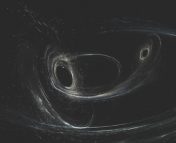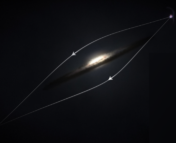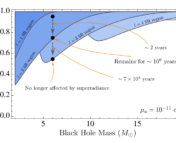
This guest post was written by Adam McMaster, a first year PhD student at the Open University in the UK. His research interests include time-domain astronomy and the transient universe (things that we can observe on short timescales). He likes taking long walks with his wife and his dog, and recently he’s been trying to learn to play the piano, with mixed results.
Title: GW190425: Observation of a Compact Binary Coalescence with Total Mass ∼3.4M⨀
Authors: The LIGO Scientific Collaboration, the Virgo Collaboration
Status: Published in ApJ Letters (open access)
Gravitational waves are ripples in space created by massive objects when they accelerate. That includes objects that orbit each other, and in the case of merging black holes or neutron stars the gravitational waves are big enough that we can detect them. In April 2019, the LIGO gravitational wave detector found its second binary neutron star (BNS) merger in an event dubbed GW190425 (the first was in August 2017). Unlike other LIGO and Virgo detections, GW190425 was definitively observed by just one detector rather than the usual two or three. The LIGO detector in Hanford, Washington, was offline for a couple of hours and missed the event, while the Virgo detector in Cascina, Italy, didn’t detect it strongly enough. That left just the LIGO detector in Livingston, Louisiana.
How do we know this is real?
Gravitational wave detections are usually confirmed by looking for multiple detections of the same event from multiple instruments. So how can the authors be sure that this detection is real? Well, there are two answers.
First, the event was detected by Virgo even if it was not as strong. The LIGO detectors had recently undergone upgrades to make them more sensitive. That’s part of the reason why the Livingston detector was able to make this discovery in the first place. The Virgo detector, however, had not had the same upgrades and wasn’t as sensitive. So, while Virgo did see an event matching the one in Livingston, the team could not rule out a statistical fluke. The Virgo detection was under the signalto-noise ratio (SNR) threshold of 4.0 (anything over 4.0 is considered a confident detection). The event was only detected with an SNR of 2.5 in Virgo, compared to 12.9 in Livingston. It seems likely that the merger did cause both events, but with such a weak signal in Virgo the authors can only confidently claim a detection in the Livingston detector.
The second answer also involves the SNR. Even without a second detection, the signal from LIGO is loud enough that the authors are sure it was not just caused by random noise. As with all good scientific claims, they have a graph to prove it:

This figure from the paper shows the SNR on the horizontal axis, plotted against a measure of how likely it was that each signal was produced by random noise, where black is the most likely, orange/yellow is less likely, and white is not likely. GW190425 (the gold star) is outside the range of all the previous background noise and not far from the previous BNS merger detection (the two diamonds, one for each LIGO detector). The authors would expect a detection like this to be a false alarm only once every 69,000 years.
What caused this?
There are two possible types of objects that could have caused this event. Both are what is left after a core-collapse supernova, when a star’s nuclear fusion comes to an abrupt halt and the centre comes crashing down. The outer layers explode, while the core is compacted into a black hole if the star is massive enough, or a neutron star if not.
Neutron stars are extremely dense. They have about 1-2 times the mass of the Sun, squeezed into roughly the radius of a large city (about 10 km). The matter they are made from is the densest matter in the universe. It’s effectively one giant atomic nucleus, mostly made of neutrons, and held up only by neutron degeneracy.
Black holes are denser still. They are what forms when gravity wins over degeneracy pressure and the collapse continues unstoppably. At their centre is a point of apparently infinite density – a mathematical infinity called a singularity. Above that there is no surface since all the mass is in the centre. Instead of a solid surface, black holes have only a Schwarzschild radius – a gravitational line in the sand, beyond which there is no return for matter or light once it falls inside. What goes in, stays in.
GW190425 was caused by the collision of two such objects. It could have been two neutron stars (a binary neutron star merger, or BNS), two black holes (binary black hole merger, or BBH), or one of each (a BH-NS merger). In a BNS merger there would be tidal effects as the neutron star matter started to collide, which would not be the case for black holes (since there are no surfaces to collide). The problem is LIGO is not sensitive enough to see those effects if they were there, so the authors do not know if those effects were truly absent or if they just couldn’t see them. Therefore, they cannot rule out the involvement of black holes. This might have been different if an electromagnetic counterpart had been found, like with the first BNS merger, but we weren’t so lucky this time.
Either way there are implications for the physics of how neutron stars or black holes form.
What does this tell us about neutron stars (and maybe black holes)?
The two objects that merged to cause GW190425 had masses between 1.61–2.52 M⨀ and 1.12–1.68M⨀, with the total mass coming in between 3.3–3.7 M⨀. This total is much higher than the mean mass of known binary neutron star (BNS) systems (2.69 M⨀). That might mean that some BNS systems form differently than previously known. That could tell us something new about the lives of the massive stars that go on to form neutron stars when they die.
If this was a binary black hole merger, the black holes could fall in the so-called mass gap between 2.5 M⨀ and 5 M⨀— too massive to be neutron stars but not massive enough to be black holes formed from stars. Whether the gap really exists is a major unanswered question. If it were proven that black holes exist in the mass gap, we would either need a new way to explain how they form from stars or it would confirm the existence of primordial black holes left over from the Big Bang.
Both are interesting possibilities. Other similar objects have been found and we are bound to find more, so it’s only a matter of time until we know more.
Edited by Jenny Calahan
Featured image credit:




